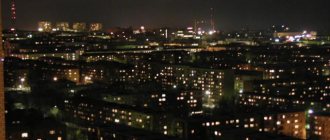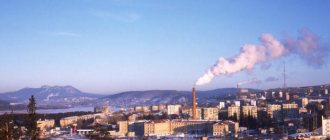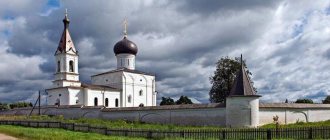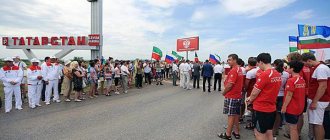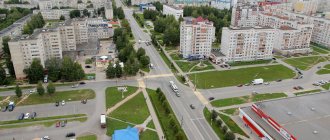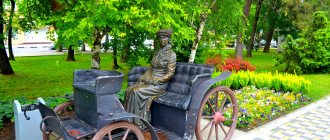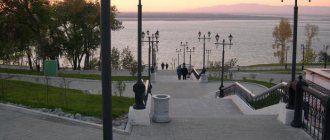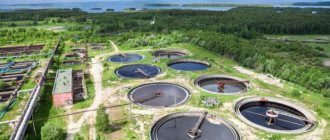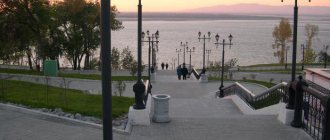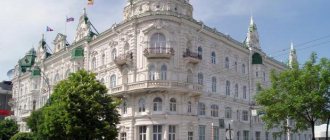General information about the population
In terms of population, Kurgan can be classified as a medium-sized city. Officially, about 325,000 people live there. If we count together those people who live in the settlements of Vargashi and Ketovo, we will get about 410,000 people. After the Kurgan region appeared on the map of Russia, and this was in 1943, the population of Kurgan increased significantly. Previously, about 100,000 people lived in the city at a time.
Infrastructure Features
The city is located at a distance of 1973 km from Moscow. Kurgan is located in the Ekaterinburg time zone, the difference with the capital is two hours. Geographic coordinates: 65 degrees 20 minutes east longitude, 55 and 27 north latitude. Transport routes from Siberia to the center of the country follow the routes of Kurgan, so the city provides a connection between Asian and European Russia.
The population complains about high prices for utilities and their poor quality. The condition of Kurgan roads is also unsatisfactory. Although every third resident has his own car, there are not enough parking spaces for everyone. Office workers have to park their cars simply on the roads in front of buildings.
There are no problems with traveling outside the city - the railway and bus stations and the airport are constantly working. You can get to Chelyabinsk, Nizhny Tagil, Shumikha, Tyumen, Yekaterinburg. Inside the Kurgan region, residents travel by buses, trolleybuses, and minibuses.
From the airport you can fly to the capital and Sochi, but the latter option is only suitable for summer time - the flight opens in the summer.
There are 88 operating kindergartens today, but new ones are opening. There are not enough schools for all the children, so they have to study in two shifts. Particular importance is attached to the comprehensive development of students. For additional activities, there are music and art institutions, five educational centers, and two children's art centers. You can get a diploma after school at 8 higher educational institutions.
Demographic situation
As for the demographic situation, here, unfortunately, the situation is a little sad, and improvements are observed only during the period of active work of various enterprises. In 2008, the population could be observed to fall to less than 300,000 people in all existing areas. As for the size of the living population from 1991, this number was more than 362,000 people, which is quite acceptable for a small city.
The population in Kurgan mainly consists of people who are in good physical shape and able to work. There are a lot of children of all ages in the city, and the number of passive pensioners is rapidly decreasing. Kurgan can safely be called the “city of March 8,” since the female population in this locality is 184,000, while the male population is only 141,000.
Statistics on the number of marriages and divorces also cannot boast of being particularly cheerful, since with 100 wedding ceremonies, in half the cases, couples soon come to the registry office to dissolve the created union. The population of Kurgan is almost entirely (96%) composed of truly Russian people. The remaining 4% is distributed to immigrants from Kazakhstan, Ukraine, Belarus and other countries. Residents of Kurgan speak Russian. In addition, a small number of genuine Tatars settled here.
Religious composition
Mighty Russia combines many religious movements. Kurgan, as a typical Russian city, is also replete with religious movements. Old Believers, Catholics, Protestants, Islamists, and Christians live here. There are some fans of Judaism, but these people are very few. There are many churches, temples, and even its own Muslim mosque. The number of Orthodox churches in the city is about 10, and there is a special prayer house for Old Believers. There are also places for worshiping the Lord, adapted for Baptists and Adventists.
Ecological situation and climate
Despite the fact that there are plenty of lakes and other bodies of water in the city, the ecological situation in Kurgan can be called favorable for life at a stretch. This is due to the presence of the very manufacturing enterprises that allow this city to flourish and change for the better. It is known that about 350 plants and factories emit tons of resins and chemical compounds harmful to the human body every day. But without these enterprises, Kurgan cannot fully exist. The city's economy depends entirely on their vitality and productivity.
The city is influenced by a very contradictory continental climate with cold winters and very hot, almost dry summers. The winds in this zone also blow mixed. This weather situation does not particularly attract tourists to Kurgan. The climate is too harsh.
The ecology in the city is also deplorable for the reason that the air is very clogged with formaldehyde and various wastes, which are eliminated extremely slowly. In just 1 year of active life, the city emits about 65,000 tons of harmful gases and other garbage into the atmosphere.
Only factories belonging to Trans-Urals can deal with the elimination of all waste accumulated during the life of the city. There are now only 30 such cleaning companies, and this number is catastrophically insufficient to provide productive assistance to the territory and city residents. A huge share of labor falls on the plant for processing unusable medical raw materials, but the Shukhovsky recycling plant copes with the set standards perfectly.
The area of Kurgan is on average 71.5 square meters. kilometers, of which approximately 0.4% of the territory is occupied by water from rivers and lakes.
Regarding the division of the city area according to administrative principles, the city is divided into 24 separate districts, which were officially established in 2007. The law on territorial division was issued by the city's governing bodies on December 27, 2007.
Climatic conditions
The climate in Kurgan is continental, but heat lovers will find it uncomfortable here. The region has short summers and harsh winters. Snowfalls continue for six months, the average temperature in winter drops to -20 degrees, and on especially cold days it reaches -40. In summer it is no higher than +20, sharp changes are observed. After prolonged heat, severe cold snaps may occur, and vice versa.
There is a wind season in Kurgan , starting in March and lasting almost two months. Due to the unfortunate geographical position, the air stagnates over the area; even eastern currents cannot clear it. Although the city is surrounded by coniferous and birch forests, the atmosphere in it is almost three times dirtier than in neighboring areas.
Most enterprises have switched to natural gas, so they emit fewer harmful substances into the air. There are few roads in the region, their traffic capacity is low, and there are quite a lot of cars.
There are many environmental problems in Kurgan. The Tobol has long become a sewer, and the Black River is also polluted. Local residents scatter garbage on beaches and lakes; spring cleanup days do not allow them to be completely removed.
The environment is deteriorating not only because of the factories; the district administration and city government practically do not care about the cleanliness of the area.
Symbolism
In 2002, the Kurgan City Duma approved the coat of arms of Kurgan. In May 2003, this symbol was included in the Russian heraldic register. What does he look like?
The sign displays an emerald-colored shield on which two white mounds (hills) are located. At the top of the shield there is a golden crown. The shield is held on one side by a marten, and on the other by a black sable. On top they hold a banner with images of the coat of arms of 1785 and 1878. The marten indicates that the city of Kurgan belongs to Russia, and the sable is the territorial emblem of Siberia.
The coat of arms of Kurgan reflects almost the entire history of this amazing region. The city's flag is also a symbolic representation of the historical past. The emerald color indicates belonging to the Trans-Urals, and white - to Siberia.
The population of Kurgan as of 2021 was 870,000 people, including residents of nearby villages and villages. As is known from the population census data, in 2014 the population density decreased by 7.4% from the initial indicators. Migration affected the city in such a way that Kurgan was empty by 70% of the total number of citizens living there. 28% of the population died.
Then a tendency towards regression began to be observed when compared with previous years. In 2015, the birth rate was higher by 454 babies. Demographers fear that in this situation, in the coming years, the city, instead of thriving, will simply die out and there will be nothing left but industrial buildings. Recruitment occurred on average by 11.9%, which is not enough to completely restore the number and populate such a territory. According to statistics, there are 1.2 times more dead citizens than born ones, which worsens the indicators of the past two years as a whole.
Demographic crisis
As for the issue of registering marriages in Kurgan, this figure has also become much lower than before. So, only 7,000 marriages were registered, which is quite a bit. Still, there are bright prospects, since not only the number of weddings has decreased, but also the number of divorces. Although the latter figure is still quite high. For example, out of 100 couples, about 67 were subject to breakup. There are fewer and fewer young people in the population of the city of Kurgan every year, and the number of people of retirement age, on the contrary, is only increasing. If we look at hard numbers, there are 292,000 elderly citizens in Kurgan. This figure exceeds all acceptable standards. It follows from this that the population of Kurgan is in dire need of replenishment.
How to get to Kurgan from Moscow and St. Petersburg
The distance between Kurgan and the Russian capital is about two thousand kilometers, and the duration of travel between the two cities by car is about 40 hours, if you drive without long breaks and choose between three highways - the M7 road (Volga), the M5 highway (Ural) ) and the federal route E22.
Moscow and Kurgan are not connected by direct train routes, but you can also get to your destination by passing train going to Pavlodar, Petropavlovsk, Karaganda, Leninogorsk and Balkhash.
Also, the Russian capital and St. Petersburg are connected with Kurgan by almost daily flights of major airlines.
The distance between Kurgan and the northern capital is over two and a half thousand kilometers, and the duration of the trip will be about 42 hours if the journey is not interrupted for a long time. You can travel in three ways – along the A114 highway, the M10 road and the M7 (“Volga”) highway.
Both cities are also connected by two direct trains with numbers 145 and 040. You can also get to Kurgan from the northern capital by passing train to Petropavlovsk.
Taking care of citizens
The legislative structures of Kurgan are trying their best to attract young professionals, on whom, according to citizens, the fruitful development of the city depends. Nowadays, events and various projects are increasingly being carried out in the city to finance and provide housing for families with small children, low-income people, disabled children and single mothers.
In Kurgan, such an area of social support for the population as feasible assistance to elderly people who have lost their legal capacity is very well developed. They also help the childless here by placing them in family planning centers for free. Large families with three or more children living in Kurgan receive decent subsidies intended to improve their living conditions. In 2015, the Kurgan authorities allocated about 295,000,000 rubles for such payments, which is much more than was previously allocated. In 2015, the amount of social payments for the purchase of housing amounted to 85,000,000 rubles. The amount of housing subsidies is calculated based on the initial cost of one square meter, as well as the initial condition of the living space.
The Russian government believes that the city of Kurgan will soon be able to break out of the demographic crisis and please the country with high development indicators.
Sights of Kurgan
In Kurgan, historical sites, museums and monuments are located mainly in the city center, so you can get around them in one day:
- House-Museum of the Decembrists .
There are interesting exhibits and facts about the life of the exiled Decembrists. The mound became a place of exile for noble youth of the 19th century - Mikhail Naryshkin, Wilhelm Kuchelbecker, Andrei Rosen. - Alexander Nevsky Cathedral. The temple was built in 1896 for 5 years. In June 1902, its consecration took place. In 1929 the church was closed. There was a local history museum there. In the early 90s, the temple was returned to believers.
- The Kurgan Aviation Museum is located near the airport. There are 15 military and civil aircraft on display here. Any visitor can go into the cockpit and “steer.”
- Kurgan Museum of Local Lore. The most visited museum in Kurgan. More than 200 thousand museum exhibits are collected here, from the beginning of civilization to the present day.
